| Flowering plant Temporal range: Early Cretaceous (Valanginian)-Recent PreꞒ Ꞓ O S D C P T J K Pg N | |
|---|---|
 Terrestrial: buttercup Terrestrial: buttercup Aquatic: water lily Aquatic: water lily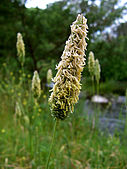 Wind-pollinated: grass Wind-pollinated: grass Insect-pollinated: apple Insect-pollinated: apple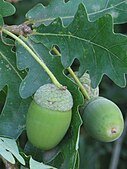 Tree: oak Tree: oak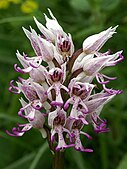 Forb: orchidDiversity of angiosperms Forb: orchidDiversity of angiosperms
| |
| Scientific classification | |
| Kingdom: | Plantae |
| Clade: | Tracheophytes |
| Clade: | Spermatophytes |
| Clade: | Angiosperms |
| Groups (APG IV) | |
| |
| Synonyms | |
Flowering plants are plants that bear flowers and fruits, and form the clade Angiospermae (/ˌændʒiəˈspərmiː/). The term 'angiosperm' is derived from the Greek words ἀγγεῖον / angeion ('container, vessel') and σπέρμα / sperma ('seed'), meaning that the seeds are enclosed within a fruit. The group was formerly called Magnoliophyta.
Angiosperms are by far the most diverse group of land plants with 64 orders, 416 families, approximately 13,000 known genera and 300,000 known species. They include all forbs (flowering plants without a woody stem), grasses and grass-like plants, a vast majority of broad-leaved trees, shrubs and vines, and most aquatic plants. Angiosperms are distinguished from the other major seed plant clade, the gymnosperms, by having flowers, xylem consisting of vessel elements instead of tracheids, endosperm within their seeds, and fruits that completely envelop the seeds. The ancestors of flowering plants diverged from the common ancestor of all living gymnosperms before the end of the Carboniferous, over 300 million years ago. In the Cretaceous, angiosperms diversified explosively, becoming the dominant group of plants across the planet.
Agriculture is almost entirely dependent on angiosperms, and a small number of flowering plant families supply nearly all plant-based food and livestock feed. Rice, maize and wheat provide half of the world's staple calorie intake, and all three plants are cereals from the Poaceae family (colloquially known as grasses). Other families provide important industrial plant products such as wood, paper and cotton, and supply numerous ingredients for beverages, sugar production, traditional medicine and modern pharmaceuticals. Flowering plants are also commonly grown for decorative purposes, with certain flowers playing significant cultural roles in many societies.
Out of the "Big Five" extinction events in Earth's history, only the Cretaceous–Paleogene extinction event had occurred while angiosperms dominated plant life on the planet. Today, the Holocene extinction affects all kingdoms of complex life on Earth, and conservation measures are necessary to protect plants in their habitats in the wild (in situ), or failing that, ex situ in seed banks or artificial habitats like botanic gardens. Otherwise, around 40% of plant species may become extinct due to human actions such as habitat destruction, introduction of invasive species, unsustainable logging, land clearing and overharvesting of medicinal or ornamental plants. Further, climate change is starting to impact plants and is likely to cause many species to become extinct by 2100.
Distinguishing features
Angiosperms are terrestrial vascular plants; like the gymnosperms, they have roots, stems, leaves, and seeds. They differ from other seed plants in several ways.
| Feature | Description | Image |
|---|---|---|
| Flowers | The reproductive organs of flowering plants, not found in any other seed plants. |  |
| Reduced gametophytes, three cells in male, seven cells with eight nuclei in female (except for basal angiosperms) | The gametophytes are smaller than those of gymnosperms. The smaller size of the pollen reduces the time between pollination and fertilization, which in gymnosperms is up to a year. |  |
| Endosperm | Endosperm forms after fertilization but before the zygote divides. It provides food for the developing embryo, the cotyledons, and sometimes the seedling. | |
| Closed carpel enclosing the ovules. | Once the ovules are fertilised, the carpels, often with surrounding tissues, develop into fruits. Gymnosperms have unenclosed seeds. | 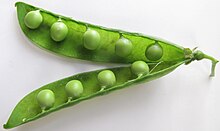 |
| Xylem made of vessel elements | Open vessel elements are stacked end to end to form continuous tubes, whereas gymnosperm xylem is made of tapered tracheids connected by small pits. |  |
Diversity
Ecological diversity
Further information: Plant ecology- Largest and smallest
-
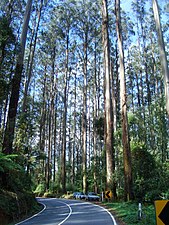 Eucalyptus regnans,
Eucalyptus regnans,
a tree almost 100 m tall -
 Wolffia arrhiza, a rootless floating freshwater plant under 2 mm across
Wolffia arrhiza, a rootless floating freshwater plant under 2 mm across
The largest angiosperms are Eucalyptus gum trees of Australia, and Shorea faguetiana, dipterocarp rainforest trees of Southeast Asia, both of which can reach almost 100 metres (330 ft) in height. The smallest are Wolffia duckweeds which float on freshwater, each plant less than 2 millimetres (0.08 in) across.
- Photosynthetic and parasitic
-
 Gunnera captures sunlight for photosynthesis over the large surfaces of its leaves, which are supported by strong veins.
Gunnera captures sunlight for photosynthesis over the large surfaces of its leaves, which are supported by strong veins.
-
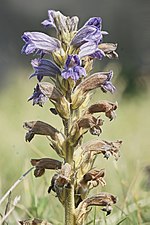 Orobanche purpurea, a parasitic broomrape with no leaves, obtains all its food from other plants.
Orobanche purpurea, a parasitic broomrape with no leaves, obtains all its food from other plants.
Considering their method of obtaining energy, some 99% of flowering plants are photosynthetic autotrophs, deriving their energy from sunlight and using it to create molecules such as sugars. The remainder are parasitic, whether on fungi like the orchids for part or all of their life-cycle, or on other plants, either wholly like the broomrapes, Orobanche, or partially like the witchweeds, Striga.
- Hot, cold, wet, dry, fresh, salt
-
 Carnegiea gigantea, the saguaro cactus, grows in hot dry deserts in Mexico and the southern United States.
Carnegiea gigantea, the saguaro cactus, grows in hot dry deserts in Mexico and the southern United States.
-
 Dryas octopetala, the mountain avens, lives in cold arctic and montane habitats in the far north of America and Eurasia.
Dryas octopetala, the mountain avens, lives in cold arctic and montane habitats in the far north of America and Eurasia.
-
 Nelumbo nucifera, the sacred lotus, grows in warm freshwater across tropical and subtropical Asia.
Nelumbo nucifera, the sacred lotus, grows in warm freshwater across tropical and subtropical Asia.
-
 Zostera seagrass grows on the seabed in sheltered coastal waters.
Zostera seagrass grows on the seabed in sheltered coastal waters.
In terms of their environment, flowering plants are cosmopolitan, occupying a wide range of habitats on land, in fresh water and in the sea. On land, they are the dominant plant group in every habitat except for frigid moss-lichen tundra and coniferous forest. The seagrasses in the Alismatales grow in marine environments, spreading with rhizomes that grow through the mud in sheltered coastal waters.
- Acid, alkaline
-
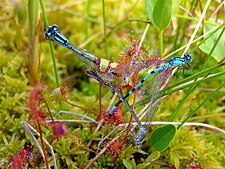 Drosera anglica, a sundew, lives in nutrient-poor acid bogs, deriving nutrients from trapped insects.
Drosera anglica, a sundew, lives in nutrient-poor acid bogs, deriving nutrients from trapped insects.
-
 Gentiana verna, the spring gentian, flourishes in dry limestone habitats.
Gentiana verna, the spring gentian, flourishes in dry limestone habitats.
Some specialised angiosperms are able to flourish in extremely acid or alkaline habitats. The sundews, many of which live in nutrient-poor acid bogs, are carnivorous plants, able to derive nutrients such as nitrate from the bodies of trapped insects. Other flowers such as Gentiana verna, the spring gentian, are adapted to the alkaline conditions found on calcium-rich chalk and limestone, which give rise to often dry topographies such as limestone pavement.
- Herbaceous, woody, climbing
-
 Geranium robertianum, herb-Robert, is an annual or biennial herb of Europe and North America.
Geranium robertianum, herb-Robert, is an annual or biennial herb of Europe and North America.
-
 Betula pendula, the silver birch, is a perennial deciduous tree of Eurasia.
Betula pendula, the silver birch, is a perennial deciduous tree of Eurasia.
-
 Lianas Austrosteenisia, Parsonsia, and Sarcopetalum climbing trees in Australia
Lianas Austrosteenisia, Parsonsia, and Sarcopetalum climbing trees in Australia
As for their growth habit, the flowering plants range from small, soft herbaceous plants, often living as annuals or biennials that set seed and die after one growing season, to large perennial woody trees that may live for many centuries and grow to many metres in height. Some species grow tall without being self-supporting like trees by climbing on other plants in the manner of vines or lianas.
Taxonomic diversity
The number of species of flowering plants is estimated to be in the range of 250,000 to 400,000. This compares to around 12,000 species of moss and 11,000 species of pteridophytes. The APG system seeks to determine the number of families, mostly by molecular phylogenetics. In the 2009 APG III there were 415 families. The 2016 APG IV added five new orders (Boraginales, Dilleniales, Icacinales, Metteniusales and Vahliales), along with some new families, for a total of 64 angiosperm orders and 416 families.
The diversity of flowering plants is not evenly distributed. Nearly all species belong to the eudicot (75%), monocot (23%), and magnoliid (2%) clades. The remaining five clades contain a little over 250 species in total; i.e. less than 0.1% of flowering plant diversity, divided among nine families. The 25 most species-rich of 443 families, containing over 166,000 species between them in their APG circumscriptions, are:
| Group | Family | English name | No. of spp. |
|---|---|---|---|
| Eudicot | Asteraceae or Compositae | daisy | 22,750 |
| Monocot | Orchidaceae | orchid | 21,950 |
| Eudicot | Fabaceae or Leguminosae | pea, legume | 19,400 |
| Eudicot | Rubiaceae | madder | 13,150 |
| Monocot | Poaceae or Gramineae | grass | 10,035 |
| Eudicot | Lamiaceae or Labiatae | mint | 7,175 |
| Eudicot | Euphorbiaceae | spurge | 5,735 |
| Eudicot | Melastomataceae | melastome | 5,005 |
| Eudicot | Myrtaceae | myrtle | 4,625 |
| Eudicot | Apocynaceae | dogbane | 4,555 |
| Monocot | Cyperaceae | sedge | 4,350 |
| Eudicot | Malvaceae | mallow | 4,225 |
| Monocot | Araceae | arum | 4,025 |
| Eudicot | Ericaceae | heath | 3,995 |
| Eudicot | Gesneriaceae | gesneriad | 3,870 |
| Eudicot | Apiaceae or Umbelliferae | parsley | 3,780 |
| Eudicot | Brassicaceae or Cruciferae | cabbage | 3,710 |
| Magnoliid dicot | Piperaceae | pepper | 3,600 |
| Monocot | Bromeliaceae | bromeliad | 3,540 |
| Eudicot | Acanthaceae | acanthus | 3,500 |
| Eudicot | Rosaceae | rose | 2,830 |
| Eudicot | Boraginaceae | borage | 2,740 |
| Eudicot | Urticaceae | nettle | 2,625 |
| Eudicot | Ranunculaceae | buttercup | 2,525 |
| Magnoliid dicot | Lauraceae | laurel | 2,500 |
Evolution
History of classification
Main article: Plant taxonomy
The botanical term "angiosperm", from Greek words angeíon (ἀγγεῖον 'bottle, vessel') and spérma (σπέρμα 'seed'), was coined in the form "Angiospermae" by Paul Hermann in 1690, including only flowering plants whose seeds were enclosed in capsules. The term angiosperm fundamentally changed in meaning in 1827 with Robert Brown, when angiosperm came to mean a seed plant with enclosed ovules. In 1851, with Wilhelm Hofmeister's work on embryo-sacs, Angiosperm came to have its modern meaning of all the flowering plants including Dicotyledons and Monocotyledons. The APG system treats the flowering plants as an unranked clade without a formal Latin name (angiosperms). A formal classification was published alongside the 2009 revision in which the flowering plants rank as the subclass Magnoliidae. From 1998, the Angiosperm Phylogeny Group (APG) has reclassified the angiosperms, with updates in the APG II system in 2003, the APG III system in 2009, and the APG IV system in 2016.
Phylogeny
External
In 2019, a molecular phylogeny of plants placed the flowering plants in their evolutionary context:
| Embryophytes |
| |||||||||||||||||||||||||||
| land plants |
Internal
The main groups of living angiosperms are:
|
Basal angiosperms Core angiosperms |
| Detailed cladogram of the 2016 Angiosperm Phylogeny Group (APG) IV classification. | |||||||||||||||||||||||||||||||||||||||||||||||||||||||||||||||||||||||||||||||||||||||||||||||||||||||||||||||||||||||||||||||||||||||||||||||||||||||||||||||||||||||||||||||||||||||||||||||||||||||||||||||||||||||||||||||||||||||||||||||||||||||||||||||||||||||||||||||||||||||||||||||||||||||||||||||||||||||||||||||||||||||||||||||||||||||||||||||||||||||||||||||||
|---|---|---|---|---|---|---|---|---|---|---|---|---|---|---|---|---|---|---|---|---|---|---|---|---|---|---|---|---|---|---|---|---|---|---|---|---|---|---|---|---|---|---|---|---|---|---|---|---|---|---|---|---|---|---|---|---|---|---|---|---|---|---|---|---|---|---|---|---|---|---|---|---|---|---|---|---|---|---|---|---|---|---|---|---|---|---|---|---|---|---|---|---|---|---|---|---|---|---|---|---|---|---|---|---|---|---|---|---|---|---|---|---|---|---|---|---|---|---|---|---|---|---|---|---|---|---|---|---|---|---|---|---|---|---|---|---|---|---|---|---|---|---|---|---|---|---|---|---|---|---|---|---|---|---|---|---|---|---|---|---|---|---|---|---|---|---|---|---|---|---|---|---|---|---|---|---|---|---|---|---|---|---|---|---|---|---|---|---|---|---|---|---|---|---|---|---|---|---|---|---|---|---|---|---|---|---|---|---|---|---|---|---|---|---|---|---|---|---|---|---|---|---|---|---|---|---|---|---|---|---|---|---|---|---|---|---|---|---|---|---|---|---|---|---|---|---|---|---|---|---|---|---|---|---|---|---|---|---|---|---|---|---|---|---|---|---|---|---|---|---|---|---|---|---|---|---|---|---|---|---|---|---|---|---|---|---|---|---|---|---|---|---|---|---|---|---|---|---|---|---|---|---|---|---|---|---|---|---|---|---|---|---|---|---|---|---|---|---|---|---|---|---|---|---|---|---|---|---|---|---|---|---|---|---|---|---|---|---|---|---|---|---|---|---|---|---|---|---|---|---|---|---|---|---|---|---|---|---|---|---|---|---|---|---|---|---|---|---|---|
|
In 2024, Alexandre R. Zuntini and colleagues constructed a tree of some 6,000 flowering plant genera, representing some 60% of the existing genera, on the basis of analysis of 353 nuclear genes in each specimen. Much of the existing phylogeny is confirmed; the rosid phylogeny is revised.

Fossil history
Main article: Fossil history of flowering plants
Fossilised spores suggest that land plants (embryophytes) have existed for at least 475 million years. However, angiosperms appear suddenly and in great diversity in the fossil record in the Early Cretaceous (~130 mya). Claimed records of flowering plants prior to this are not widely accepted. Molecular evidence suggests that the ancestors of angiosperms diverged from the gymnosperms during the late Devonian, about 365 million years ago. The origin time of the crown group of flowering plants remains contentious. By the Late Cretaceous, angiosperms appear to have dominated environments formerly occupied by ferns and gymnosperms. Large canopy-forming trees replaced conifers as the dominant trees close to the end of the Cretaceous, 66 million years ago. The radiation of herbaceous angiosperms occurred much later.
Reproduction
Flowers
Main articles: Flower and Plant reproductive morphology
The characteristic feature of angiosperms is the flower. Its function is to ensure fertilization of the ovule and development of fruit containing seeds. It may arise terminally on a shoot or from the axil of a leaf. The flower-bearing part of the plant is usually sharply distinguished from the leaf-bearing part, and forms a branch-system called an inflorescence.
Flowers produce two kinds of reproductive cells. Microspores, which divide to become pollen grains, are the male cells; they are borne in the stamens. The female cells, megaspores, divide to become the egg cell. They are contained in the ovule and enclosed in the carpel; one or more carpels form the pistil.
The flower may consist only of these parts, as in wind-pollinated plants like the willow, where each flower comprises only a few stamens or two carpels. In insect- or bird-pollinated plants, other structures protect the sporophylls and attract pollinators. The individual members of these surrounding structures are known as sepals and petals (or tepals in flowers such as Magnolia where sepals and petals are not distinguishable from each other). The outer series (calyx of sepals) is usually green and leaf-like, and functions to protect the rest of the flower, especially the bud. The inner series (corolla of petals) is, in general, white or brightly colored, is more delicate in structure, and attracts pollinators by colour, scent, and nectar.
Most flowers are hermaphroditic, producing both pollen and ovules in the same flower, but some use other devices to reduce self-fertilization. Heteromorphic flowers have carpels and stamens of differing lengths, so animal pollinators cannot easily transfer pollen between them. Homomorphic flowers may use a biochemical self-incompatibility to discriminate between self and non-self pollen grains. Dioecious plants such as holly have male and female flowers on separate plants. Monoecious plants have separate male and female flowers on the same plant; these are often wind-pollinated, as in maize, but include some insect-pollinated plants such as Cucurbita squashes.
Fertilisation and embryogenesis
Main articles: Fertilization and Plant embryogenesisDouble fertilization requires two sperm cells to fertilise cells in the ovule. A pollen grain sticks to the stigma at the top of the pistil, germinates, and grows a long pollen tube. A haploid generative cell travels down the tube behind the tube nucleus. The generative cell divides by mitosis to produce two haploid (n) sperm cells. The pollen tube grows from the stigma, down the style and into the ovary. When it reaches the micropyle of the ovule, it digests its way into one of the synergids, releasing its contents including the sperm cells. The synergid that the cells were released into degenerates; one sperm makes its way to fertilise the egg cell, producing a diploid (2n) zygote. The second sperm cell fuses with both central cell nuclei, producing a triploid (3n) cell. The zygote develops into an embryo; the triploid cell develops into the endosperm, the embryo's food supply. The ovary develops into a fruit. and each ovule into a seed.
Fruit and seed

As the embryo and endosperm develop, the wall of the embryo sac enlarges and combines with the nucellus and integument to form the seed coat. The ovary wall develops to form the fruit or pericarp, whose form is closely associated with type of seed dispersal system.
Other parts of the flower often contribute to forming the fruit. For example, in the apple, the hypanthium forms the edible flesh, surrounding the ovaries which form the tough cases around the seeds.
Apomixis, setting seed without fertilization, is found naturally in about 2.2% of angiosperm genera. Some angiosperms, including many citrus varieties, are able to produce fruits through a type of apomixis called nucellar embryony.
Sexual selection
This section is an excerpt from Sexual selection in flowering plants. Sexual selection is described as natural selection arising through preference by one sex for certain characteristics in individuals of the other sex. Sexual selection is a common concept in animal evolution but, with plants, it is often overlooked because many plants are hermaphrodites. Flowering plants show many characteristics that are often sexually selected for. For example, flower symmetry, nectar production, floral structure, and inflorescences are just a few of the many secondary sex characteristics acted upon by sexual selection. Sexual dimorphisms and reproductive organs can also be affected by sexual selection in flowering plants.Adaptive function of flowers
Charles Darwin in his 1878 book The Effects of Cross and Self-Fertilization in the Vegetable Kingdom in the initial paragraph of chapter XII noted "The first and most important of the conclusions which may be drawn from the observations given in this volume, is that generally cross-fertilisation is beneficial and self-fertilisation often injurious, at least with the plants on which I experimented." Flowers emerged in plant evolution as an adaptation for the promotion of cross-fertilisation (outcrossing), a process that allows the masking of deleterious mutations in the genome of progeny. The masking effect is known as genetic complementation. This beneficial effect of cross-fertilisation on progeny is also referred to as hybrid vigor or heterosis. Once flowers became established in a lineage as an evolutionary adaptation to promote cross-fertilization, subsequent switching to inbreeding usually becomes disadvantageous, in large part because it allows expression of the previously masked deleterious recessive mutations, i.e. inbreeding depression.
Also, Meiosis in flowering plants provides a direct mechanism for repairing DNA through genetic recombination in reproductive tissues. Sexual reproduction appears to be required for maintaining long-term genomic integrity and only infrequent combinations of extrinsic and intrinsic factors permit shifts to asexuality. Thus the two fundamental aspects of sexual reproduction in flowering plants, cross-fertilization (outcrossing) and meiosis appear to be maintained respectively by the advantages of genetic complementation and recombinational repair.
Main article: Human uses of plantsPractical uses


Agriculture is almost entirely dependent on angiosperms, which provide virtually all plant-based food and livestock feed. Much of this food derives from a small number of flowering plant families. For instance, half of the world's calorie intake is supplied by just three plants – wheat, rice and maize.
| Family | English | Example foods from that family |
|---|---|---|
| Poaceae | Grasses, cereals | Most feedstocks, inc. rice, maize, wheat, barley, rye, oats, pearl millet, sugar cane, sorghum |
| Fabaceae | Legumes, pea family | Peas, beans, lentils; for animal feed, clover, alfalfa |
| Solanaceae | Nightshade family | Potatoes, tomatoes, peppers, aubergines |
| Cucurbitaceae | Gourd family | Squashes, cucumbers, pumpkins, melons |
| Brassicaceae | Cabbage family | Cabbage and its varieties, e.g. Brussels sprout, broccoli; mustard; oilseed rape |
| Apiaceae | Parsley family | Parsnip, carrot, parsley, coriander, fennel, cumin, caraway |
| Rutaceae | Rue family | Oranges, lemons, grapefruits |
| Rosaceae | Rose family | Apples, pears, cherries, apricots, plums, peaches |
Flowering plants provide a diverse range of materials in the form of wood, paper, fibers such as cotton, flax, and hemp, medicines such as digoxin and opioids, and decorative and landscaping plants. Coffee and hot chocolate are beverages from flowering plants.
Cultural uses

Both real and fictitious plants play a wide variety of roles in literature and film. Flowers are the subjects of many poems by poets such as William Blake, Robert Frost, and Rabindranath Tagore. Bird-and-flower painting (Huaniaohua) is a kind of Chinese painting that celebrates the beauty of flowering plants. Flowers have been used in literature to convey meaning by authors including William Shakespeare. Flowers are used in a variety of art forms which arrange cut or living plants, such as bonsai, ikebana, and flower arranging. Ornamental plants have sometimes changed the course of history, as in tulipomania. Many countries and regions have floral emblems; a survey of 70 of these found that the most popular flowering plant family for such emblems is Orchidaceae at 15.7% (11 emblems), followed by Fabaceae at 10% (7 emblems), and Asparagaceae, Asteraceae, and Rosaceae all at 5.7% (4 emblems each).
Conservation
Further information: Conservation biology and Effects of climate change on plant biodiversity
Human impact on the environment has driven a range of species extinct and is threatening even more today. Multiple organizations such as IUCN and Royal Botanic Gardens, Kew suggest that around 40% of plant species are threatened with extinction. The majority are threatened by habitat loss, but activities such as logging of wild timber trees and collection of medicinal plants, or the introduction of non-native invasive species, also play a role.
Relatively few plant diversity assessments currently consider climate change, yet it is starting to impact plants as well. About 3% of flowering plants are very likely to be driven extinct within a century at 2 °C (3.6 °F) of global warming, and 10% at 3.2 °C (5.8 °F). In worst-case scenarios, half of all tree species may be driven extinct by climate change over that timeframe.
Conservation in this context is the attempt to prevent extinction, whether in situ by protecting plants and their habitats in the wild, or ex situ in seed banks or as living plants. Some 3000 botanic gardens around the world maintain living plants, including over 40% of the species known to be threatened, as an "insurance policy against extinction in the wild." The United Nations' Global Strategy for Plant Conservation asserts that "without plants, there is no life". It aims to "halt the continuing loss of plant diversity" throughout the world.
References
- ^ APG 2016.
- Cronquist 1960.
- Reveal, James L. (2011) . "Indices Nominum Supragenericorum Plantarum Vascularium – M". Archived from the original on 27 August 2013. Retrieved 28 August 2017.
- Takhtajan 1964.
- Lindley, J. (1830). Introduction to the Natural System of Botany. London: Longman, Rees, Orme, Brown, and Green. xxxvi. Archived from the original on 27 August 2017. Retrieved 29 January 2018.
- Cantino, Philip D.; Doyle, James A.; Graham, Sean W.; et al. (2007). "Towards a phylogenetic nomenclature of Tracheophyta". Taxon. 56 (3): E1 – E44. doi:10.2307/25065865. JSTOR 25065865.
- Takhtajan 1980.
- Christenhusz, M. J. M.; Byng, J. W. (2016). "The number of known plants species in the world and its annual increase". Phytotaxa. 261 (3): 201–217. doi:10.11646/phytotaxa.261.3.1. Archived from the original on 6 April 2017. Retrieved 21 February 2022.
- "Angiosperms | OpenStax Biology 2e". courses.lumenlearning.com. Archived from the original on 19 July 2021. Retrieved 19 July 2021.
- Friedman, William E.; Ryerson, Kirsten C. (2009). "Reconstructing the ancestral female gametophyte of angiosperms: Insights from Amborella and other ancient lineages of flowering plants". American Journal of Botany. 96 (1): 129–143. doi:10.3732/ajb.0800311. PMID 21628180.
- Raven, Peter H.; Evert, Ray F.; Eichhorn, Susan E. (2005). Biology of Plants. W. H. Freeman. pp. 376–. ISBN 978-0-7167-1007-3.
- Williams, Joseph H. (2012). "The evolution of pollen germination timing in flowering plants: Austrobaileya scandens (Austrobaileyaceae)". AoB Plants. 2012: pls010. doi:10.1093/aobpla/pls010. PMC 3345124. PMID 22567221.
- Baroux, C.; Spillane, C.; Grossniklaus, U. (2002). "Evolutionary origins of the endosperm in flowering plants". Genome Biology. 3 (9) reviews1026.1: reviews1026.1. doi:10.1186/gb-2002-3-9-reviews1026. PMC 139410. PMID 12225592.
- Gonçalves, Beatriz (15 December 2021). "Case not closed: the mystery of the origin of the carpel". EvoDevo. 12 (1): 14. doi:10.1186/s13227-021-00184-z. ISSN 2041-9139. PMC 8672599. PMID 34911578.
- Baas, Pieter (1982). "Systematic, phylogenetic, and ecological wood anatomy — History and perspectives". New Perspectives in Wood Anatomy. Forestry Sciences. Vol. 1. Dordrecht: Springer Netherlands. pp. 23–58. doi:10.1007/978-94-017-2418-0_2. ISBN 978-90-481-8269-5. ISSN 0924-5480.
- "Menara, yellow meranti, Shorea". Guinness World Records. 6 January 2019. Retrieved 8 May 2023.
yellow meranti (Shorea faguetiana) ... 98.53 m (323 ft 3.1 in) tall ... swamp gum (Eucalyptus regnans) ... In 2014, it had a tape-drop height of 99.82 m (327 ft 5.9 in)
- "The Charms of Duckweed". 25 November 2009. Archived from the original on 25 November 2009. Retrieved 5 July 2022.
- Leake, J.R. (1994). "The biology of myco-heterotrophic ('saprophytic') plants". New Phytologist. 127 (2): 171–216. doi:10.1111/j.1469-8137.1994.tb04272.x. PMID 33874520. S2CID 85142620.
- Westwood, James H.; Yoder, John I.; Timko, Michael P.; dePamphilis, Claude W. (2010). "The evolution of parasitism in plants". Trends in Plant Science. 15 (4): 227–235. Bibcode:2010TPS....15..227W. doi:10.1016/j.tplants.2010.01.004. ISSN 1360-1385. PMID 20153240.
- "Angiosperms". University of Nevada, Las Vegas. Retrieved 6 May 2023.
- Kendrick, Gary A.; Orth, Robert J.; Sinclair, Elizabeth A.; Statton, John (2022). "Effect of climate change on regeneration of seagrasses from seeds". Plant Regeneration from Seeds. pp. 275–283. doi:10.1016/b978-0-12-823731-1.00011-1. ISBN 978-0-1282-3731-1.
- ^ Karlsson, P. S.; Pate, J. S. (1992). "Contrasting effects of supplementary feeding of insects or mineral nutrients on the growth and nitrogen and phosphorous economy of pygmy species of Drosera". Oecologia. 92 (1): 8–13. Bibcode:1992Oecol..92....8K. doi:10.1007/BF00317256. PMID 28311806. S2CID 13038192.
- ^ Pardoe, H. S. (1995). Mountain Plants of the British Isles. National Museum of Wales. p. 24. ISBN 978-0-7200-0423-6.
- Hart, Robin (1977). "Why are Biennials so Few?". The American Naturalist. 111 (980): 792–799. doi:10.1086/283209. JSTOR 2460334. S2CID 85343835.
- Rowe, Nick; Speck, Thomas (12 January 2005). "Plant growth forms: an ecological and evolutionary perspective". New Phytologist. 166 (1): 61–72. doi:10.1111/j.1469-8137.2004.01309.x. ISSN 0028-646X. PMID 15760351.
- Thorne, R.F. (2002). "How many species of seed plants are there?". Taxon. 51 (3): 511–522. doi:10.2307/1554864. JSTOR 1554864.
- Scotland, R. W.; Wortley, A. H. (2003). "How many species of seed plants are there?". Taxon. 52 (1): 101–104. doi:10.2307/3647306. JSTOR 3647306.
- Govaerts, R. (2003). "How many species of seed plants are there? – a response". Taxon. 52 (3): 583–584. doi:10.2307/3647457. JSTOR 3647457.
- Goffinet, Bernard; Buck, William R. (2004). "Systematics of the Bryophyta (Mosses): From molecules to a revised classification". Monographs in Systematic Botany. 98: 205–239.
- Raven, Peter H.; Evert, Ray F.; Eichhorn, Susan E. (2005). Biology of Plants (7th ed.). New York: W. H. Freeman and Company. ISBN 0-7167-1007-2.
- ^ APG 2009.
- Stevens, P. F. (2011). "Angiosperm Phylogeny Website (at Missouri Botanical Garden)". Archived from the original on 20 January 2022. Retrieved 21 February 2022.
- "Kew Scientist 30" (PDF). October 2006. Archived from the original (PDF) on 27 September 2007.
- Balfour & Rendle 1911, p. 9.
- Brown, Robert (1827). "Character and description of Kingia, a new genus of plants found on the southwest coast of New Holland: with observations on the structure of its unimpregnated ovulum; and on the female flower of Cycadeae and Coniferae". In King, Philip Parker (ed.). Narrative of a Survey of the Intertropical and Western Coasts of Australia: Performed Between the Years 1818 and 1822. J. Murray. pp. 534–565. OCLC 185517977.
- ^ Buggs, Richard J.A. (January 2021). "The origin of Darwin's "abominable mystery"". American Journal of Botany. 108 (1): 22–36. doi:10.1002/ajb2.1592. PMID 33482683. S2CID 231689158.
- ^ Balfour & Rendle 1911, p. 10.
- Chase & Reveal 2009.
- APG 2003.
- "As easy as APG III – Scientists revise the system of classifying flowering plants" (Press release). The Linnean Society of London. 8 October 2009. Archived from the original on 26 November 2010. Retrieved 2 October 2009.
- Leebens-Mack, M.; Barker, M.; Carpenter, E.; et al. (2019). "One thousand plant transcriptomes and the phylogenomics of green plants". Nature. 574 (7780): 679–685. doi:10.1038/s41586-019-1693-2. PMC 6872490. PMID 31645766.
- Guo, Xing (26 November 2021). "Chloranthus genome provides insights into the early diversification of angiosperms". Nature Communications. 12 (1): 6930. Bibcode:2021NatCo..12.6930G. doi:10.1038/s41467-021-26922-4. PMC 8626473. PMID 34836973.
- ^ Palmer, Jeffrey D.; Soltis, Douglas E.; Chase, Mark W. (October 2004). "The plant tree of life: an overview and some points of view". American Journal of Botany. 91 (10): 1437–45. doi:10.3732/ajb.91.10.1437. PMID 21652302., Figure 2 Archived 2 February 2011 at the Wayback Machine
- Christenhusz, Maarten J. M.; Fay, Michael F.; Chase, Mark W. (2017). Plants of the World: An Illustrated Encyclopedia of Vascular Plants. University of Chicago Press. p. 114. ISBN 978-0-226-52292-0.
- Massoni, Julien; Couvreur, Thomas L.P.; Sauquet, Hervé (18 March 2015). "Five major shifts of diversification through the long evolutionary history of Magnoliidae (angiosperms)". BMC Evolutionary Biology. 15 (1): 49. Bibcode:2015BMCEE..15...49M. doi:10.1186/s12862-015-0320-6. PMC 4377182. PMID 25887386.
- Zuntini, Alexandre R.; Carruthers, Tom; Maurin, Olivier; Bailey, Paul C.; Leempoel, Kevin; Brewer, Grace E.; et al. (24 April 2024). "Phylogenomics and the rise of the angiosperms". Nature. 629 (8013): 843–850. Bibcode:2024Natur.629..843Z. doi:10.1038/s41586-024-07324-0. ISSN 0028-0836. PMC 11111409. PMID 38658746.
- Edwards, D. (June 2000). "The role of mid-palaeozoic mesofossils in the detection of early bryophytes". Philosophical Transactions of the Royal Society of London. Series B, Biological Sciences. 355 (1398): 733–54, discussion 754–5. doi:10.1098/rstb.2000.0613. PMC 1692787. PMID 10905607.
- Herendeen, Patrick S.; Friis, Else Marie; Pedersen, Kaj Raunsgaard; Crane, Peter R. (3 March 2017). "Palaeobotanical redux: revisiting the age of the angiosperms". Nature Plants. 3 (3): 17015. Bibcode:2017NatPl...317015H. doi:10.1038/nplants.2017.15. ISSN 2055-0278. PMID 28260783. S2CID 205458714.
- Friedman, William E. (January 2009). "The meaning of Darwin's "abominable mystery"". American Journal of Botany. 96 (1): 5–21. doi:10.3732/ajb.0800150. PMID 21628174.
- Bateman, Richard M (1 January 2020). Ort, Donald (ed.). "Hunting the Snark: the flawed search for mythical Jurassic angiosperms". Journal of Experimental Botany. 71 (1): 22–35. doi:10.1093/jxb/erz411. ISSN 0022-0957. PMID 31538196.
- Stull, Gregory W.; Qu, Xiao-Jian; Parins-Fukuchi, Caroline; et al. (19 July 2021). "Gene duplications and phylogenomic conflict underlie major pulses of phenotypic evolution in gymnosperms". Nature Plants. 7 (8): 1015–1025. Bibcode:2021NatPl...7.1015S. doi:10.1038/s41477-021-00964-4. PMID 34282286. S2CID 236141481. Archived from the original on 10 January 2022. Retrieved 10 January 2022.
- Sauquet, Hervé; Ramírez-Barahona, Santiago; Magallón, Susana (24 June 2022). Melzer, Rainer (ed.). "What is the age of flowering plants?". Journal of Experimental Botany. 73 (12): 3840–3853. doi:10.1093/jxb/erac130. ISSN 0022-0957. PMID 35438718.
- Sadava, David; Heller, H. Craig; Orians, Gordon H.; et al. (December 2006). Life: the science of biology. Macmillan. pp. 477–. ISBN 978-0-7167-7674-1. Archived from the original on 23 December 2011. Retrieved 4 August 2010.
- Stewart, Wilson Nichols; Rothwell, Gar W. (1993). Paleobotany and the evolution of plants (2nd ed.). Cambridge University Press. p. 498. ISBN 978-0-521-23315-6.
- Willson, Mary F. (1 June 1979). "Sexual Selection in Plants". The American Naturalist. 113 (6): 777–790. doi:10.1086/283437. S2CID 84970789. Archived from the original on 9 November 2021. Retrieved 9 November 2021.
- Bredmose, N. (2003). "Growth Regulation: Axillary Bud Growth". Encyclopedia of Rose Science. Elsevier. pp. 374–381. doi:10.1016/b0-12-227620-5/00017-3. ISBN 9780122276200.
- ^ Salisbury, Frank B.; Parke, Robert V. (1970). "Sexual Reproduction". In Salisbury, Frank B.; Parke, Robert V. (eds.). Vascular Plants: Form and Function. Fundamentals of Botany Series. London: Macmillan Education. pp. 185–195. doi:10.1007/978-1-349-00364-8_13. ISBN 978-1-349-00364-8.
- De Craene & P. 2010, p. 7.
- D. Mauseth 2016, p. 225.
- De Craene & P. 2010, p. 8.
- D. Mauseth 2016, p. 226.
- Ainsworth, C. (August 2000). "Boys and Girls Come Out to Play: The Molecular Biology of Dioecious Plants". Annals of Botany. 86 (2): 211–221. doi:10.1006/anbo.2000.1201.
- Batygina, T.B. (2019). Embryology of Flowering Plants: Terminology and Concepts, Vol. 3: Reproductive Systems. CRC Press. p. 43. ISBN 978-1-4398-4436-6.
- Bortiri, E.; Hake, S. (13 January 2007). "Flowering and determinacy in maize". Journal of Experimental Botany. 58 (5). Oxford University Press (OUP): 909–916. doi:10.1093/jxb/erm015. ISSN 0022-0957. PMID 17337752.
- Mabberley, D. J. (2008). The Plant Book: A Portable Dictionary of the Vascular Plants. Cambridge: Cambridge University Press. p. 235. ISBN 978-0-521-82071-4.
- "Angiosperms". Flora of China. Retrieved 21 February 2015 – via eFloras.org, Missouri Botanical Garden, St. Louis, MO & Harvard University Herbaria, Cambridge, MA.
- Berger, F. (January 2008). "Double-fertilization, from myths to reality". Sexual Plant Reproduction. 21 (1): 3–5. doi:10.1007/s00497-007-0066-4. S2CID 8928640.
- Eriksson, O. (2008). "Evolution of Seed Size and Biotic Seed Dispersal in Angiosperms: Paleoecological and Neoecological Evidence". International Journal of Plant Sciences. 169 (7): 863–870. doi:10.1086/589888. S2CID 52905335.
- "Fruit Anatomy". Fruit & Nut Research & Information Center. University of California. Archived from the original on 2 May 2023.
- Hojsgaard, D.; Klatt, S.; Baier, R.; et al. (September 2014). "Taxonomy and Biogeography of Apomixis in Angiosperms and Associated Biodiversity Characteristics". Critical Reviews in Plant Sciences. 33 (5): 414–427. Bibcode:2014CRvPS..33..414H. doi:10.1080/07352689.2014.898488. PMC 4786830. PMID 27019547.
- Gentile, Alessandra (18 March 2020). The Citrus Genome. Springer Nature. p. 171. ISBN 978-3-030-15308-3. Archived from the original on 14 April 2021. Retrieved 13 December 2020.
- Ashman, Tia-Lynn; Delph, Lynda F. (1 August 2006). "Trait selection in flowering plants: how does sexual selection contribute?". Integrative and Comparative Biology. 46 (4): 465–472. doi:10.1093/icb/icj038. ISSN 1540-7063. PMID 21672758.
- Darwin, C. R. 1878. The effects of cross and self fertilisation in the vegetable kingdom. London: John Murray". darwin-online.org.uk
- ^ Bernstein H, Byerly HC, Hopf FA, Michod RE. Genetic damage, mutation, and the evolution of sex. Science. 1985 Sep 20;229(4719):1277–81. doi: 10.1126/science.3898363. PMID 3898363
- ^ Hörandl E. Apomixis and the paradox of sex in plants. Ann Bot. 2024 Mar 18:mcae044. doi: 10.1093/aob/mcae044. Epub ahead of print. PMID 38497809
- ^ Dilcher, David L.; Cronquist, Arthur; Zimmermann, Martin Huldrych; Stevens, Peter; Stevenson, Dennis William; Berry, Paul E. (8 March 2016). "Angiosperm: Significance to Humans". Encyclopedia Britannica.
- McKie, Robin (16 July 2017). "Maize, rice, wheat: alarm at rising climate risk to vital crops". The Observer. Retrieved 30 July 2023.
- "Rutaceae". Botanical Dermatology Database. Archived from the original on 19 July 2019.
- Zhang, Shu-Dong; Jin, Jian-Jun; Chen, Si-Yun; et al. (2017). "Diversification of Rosaceae since the Late Cretaceous based on plastid phylogenomics". New Phytologist. 214 (3): 1355–1367. doi:10.1111/nph.14461. ISSN 1469-8137. PMID 28186635.
- "Literary Plants". Nature Plants. 1 (11): 15181. 2015. Bibcode:2015NatPl...115181.. doi:10.1038/nplants.2015.181. PMID 27251545.
- "Flower Poems". Poem Hunter. Retrieved 21 June 2016.
- "Nature's Song: Chinese Bird and Flower Paintings". Museum Wales. Archived from the original on 4 August 2022. Retrieved 4 August 2022.
- "The Language of Flowers". Folger Shakespeare Library. Archived from the original on 19 September 2014. Retrieved 31 May 2013.
- Lambert, Tim (2014). "A Brief History of Gardening". British Broadcasting Corporation. Retrieved 21 June 2016.
- Lim, Reuben; Tan, Heok; Tan, Hugh (2013). Official Biological Emblems of the World. Singapore: Raffles Museum of Biodiversity Research. ISBN 978-9-8107-4147-1.
- Block, Sebastián; Maechler, Marc-Jacques; Levine, Jacob I.; Alexander, Jake M.; Pellissier, Loïc; Levine, Jonathan M. (26 August 2022). "Ecological lags govern the pace and outcome of plant community responses to 21st-century climate change". Ecology Letters. 25 (10): 2156–2166. Bibcode:2022EcolL..25.2156B. doi:10.1111/ele.14087. PMC 9804264. PMID 36028464.
- ^ Lughadha, Eimear Nic; Bachman, Steven P.; Leão, Tarciso C. C.; Forest, Félix; Halley, John M.; Moat, Justin; Acedo, Carmen; Bacon, Karen L.; Brewer, Ryan F. A.; Gâteblé, Gildas; Gonçalves, Susana C.; Govaerts, Rafaël; Hollingsworth, Peter M.; Krisai-Greilhuber, Irmgard; de Lirio, Elton J.; Moore, Paloma G. P.; Negrão, Raquel; Onana, Jean Michel; Rajaovelona, Landy R.; Razanajatovo, Henintsoa; Reich, Peter B.; Richards, Sophie L.; Rivers, Malin C.; Cooper, Amanda; Iganci, João; Lewis, Gwilym P.; Smidt, Eric C.; Antonelli, Alexandre; Mueller, Gregory M.; Walker, Barnaby E. (29 September 2020). "Extinction risk and threats to plants and fungi". Plants People Planet. 2 (5): 389–408. doi:10.1002/ppp3.10146. hdl:10316/101227. S2CID 225274409.
- ^ "Botanic Gardens and Plant Conservation". Botanic Gardens Conservation International. Retrieved 19 July 2023.
- Wiens, John J. (2016). "Climate-Related Local Extinctions Are Already Widespread among Plant and Animal Species". PLOS Biology. 14 (12): e2001104. doi:10.1371/journal.pbio.2001104. hdl:10150/622757.
- Shivanna, K. R. (2019). "The 'Sixth Mass Extinction Crisis' and Its Impact on Flowering Plants". Biodiversity and Chemotaxonomy. Sustainable Development and Biodiversity. Vol. 24. Cham: Springer International Publishing. pp. 15–42. doi:10.1007/978-3-030-30746-2_2. ISBN 978-3-030-30745-5.
- Parmesan, C., M.D. Morecroft, Y. Trisurat et al. (2022) Chapter 2: Terrestrial and Freshwater Ecosystems and Their Services in "Terrestrial and Freshwater Ecosystems and Their Services". Climate Change 2022 – Impacts, Adaptation and Vulnerability. Cambridge University Press. 2023. pp. 197–378. doi:10.1017/9781009325844.004. ISBN 978-1-009-32584-4.
- "Plant Conservation Around the World". Cambridge University Botanic Garden. 2020. Retrieved 19 July 2023.
- ^ "Updated Global Strategy for Plant Conservation 2011–2020". Convention on Biological Diversity. 3 July 2023. Retrieved 19 July 2023.
Bibliography
Articles, books and chapters
 This article incorporates text from a publication now in the public domain: Balfour, Isaac Bayley; Rendle, Alfred Barton (1911). "Angiosperms". In Chisholm, Hugh (ed.). Encyclopædia Britannica. Vol. 2 (11th ed.). Cambridge University Press. pp. 9–14.
This article incorporates text from a publication now in the public domain: Balfour, Isaac Bayley; Rendle, Alfred Barton (1911). "Angiosperms". In Chisholm, Hugh (ed.). Encyclopædia Britannica. Vol. 2 (11th ed.). Cambridge University Press. pp. 9–14.- APG (2003). "An update of the Angiosperm Phylogeny Group classification for the orders and families of flowering plants: APG II". Botanical Journal of the Linnean Society. 141 (4): 399–436. doi:10.1046/j.1095-8339.2003.t01-1-00158.x.
- APG (2009). "An update of the Angiosperm Phylogeny Group classification for the orders and families of flowering plants: APG III". Botanical Journal of the Linnean Society. 161 (2): 105–121. doi:10.1111/j.1095-8339.2009.00996.x. hdl:10654/18083.
- APG (2016). "An update of the Angiosperm Phylogeny Group classification for the orders and families of flowering plants: APG IV". Botanical Journal of the Linnean Society. 181 (1): 1–20. doi:10.1111/boj.12385.
- Becker, Kenneth M. (February 1973). "A Comparison of Angiosperm Classification Systems". Taxon. 22 (1): 19–50. doi:10.2307/1218032. JSTOR 1218032.
- Bell, Adrian D. (2008) . Plant Form. An Illustrated Guide to Flowering Plant Morphology. Portland, Oregon: Timber Press. ISBN 978-0-88192-850-1.
- Bell, C.D.; Soltis, D.E.; Soltis, P.S. (2010). "The Age and Diversification of the Angiosperms Revisited". American Journal of Botany. 97 (8): 1296–1303. doi:10.3732/ajb.0900346. PMID 21616882. S2CID 207613985.
- Chase, Mark W.; Reveal, James L. (2009). "A phylogenetic classification of the land plants to accompany APG III". Botanical Journal of the Linnean Society. 161 (2): 122–127. doi:10.1111/j.1095-8339.2009.01002.x.
- De Craene, Ronse; P., Louis (2010). Floral Diagrams. Cambridge: Cambridge University Press. doi:10.1017/cbo9780511806711. ISBN 978-0-511-80671-1.
- Cromie, William J. (16 December 1999). "Oldest Known Flowering Plants Identified By Genes". Harvard University Gazette.
- Cronquist, Arthur (October 1960). "The divisions and classes of plants". The Botanical Review. 26 (4): 425–482. Bibcode:1960BotRv..26..425C. doi:10.1007/BF02940572. S2CID 43144314.
- Cronquist, Arthur (1981). An Integrated System of Classification of Flowering Plants. New York: Columbia Univ. Press. ISBN 978-0-231-03880-5.
- Dahlgren, R. M. T. (February 1980). "A revised system of classification of the angiosperms". Botanical Journal of the Linnean Society. 80 (2): 91–124. doi:10.1111/j.1095-8339.1980.tb01661.x.
- Dahlgren, Rolf (February 1983). "General aspects of angiosperm evolution and macrosystematics". Nordic Journal of Botany. 3 (1): 119–149. doi:10.1111/j.1756-1051.1983.tb01448.x.
- Dilcher, D. (2000). "Toward a new synthesis: Major evolutionary trends in the angiosperm fossil record". Proceedings of the National Academy of Sciences. 97 (13): 7030–7036. Bibcode:2000PNAS...97.7030D. doi:10.1073/pnas.97.13.7030. PMC 34380. PMID 10860967.
- Heywood, V. H.; Brummitt, R. K.; Culham, A.; Seberg, O. (2007). Flowering Plant Families of the World. Richmond Hill, Ontario, Canada: Firefly Books. ISBN 978-1-55407-206-4.
- Hill, Christopher; Crane, Peter (January 1982). "Evolutionary Cladistics and the origin of Angiosperms". In Joysey, Kenneth Alan; Friday, A.E. (eds.). Problems of Phylogenetic Reconstruction. Special Volumes. Vol. 21. London: Systematics Association. pp. 269–361. ISBN 978-0-12-391250-3.
- Lersten, Nels R. (2004). Flowering plant embryology with emphasis on economic species. Ames, Iowa: Blackwell Pub. ISBN 978-0-470-75267-8.
- D. Mauseth, James (2016). Botany: An Introduction to Plant Biology (6th ed.). Jones & Bartlett Learning. ISBN 978-1-284-07753-7.
- Pooja (2004). Angiosperms. New Delhi: Discovery. ISBN 978-81-7141-788-9.
- Raven, P.H.; Evert, R.F.; Eichhorn, S.E. (2004). Biology of Plants (7th ed.). W.H. Freeman.
- Sattler, R. (1973). Organogenesis of Flowers. A Photographic Text-Atlas. University of Toronto Press.
- Simpson, Michael G. (2010). Plant Systematics (2nd ed.). Academic Press. ISBN 978-0-08-092208-9.
- Soltis, Pamela S; Soltis, Douglas E (April 2016). "Ancient WGD events as drivers of key innovations in angiosperms". Current Opinion in Plant Biology. 30: 159–165. Bibcode:2016COPB...30..159S. doi:10.1016/j.pbi.2016.03.015. PMID 27064530.
- Takhtajan, A. (June 1964). "The Taxa of the Higher Plants above the Rank of Order". Taxon. 13 (5): 160–164. doi:10.2307/1216134. JSTOR 1216134.
- Takhtajan, A. (July–September 1980). "Outline of the Classification of Flowering Plants (Magnoliophyta)". Botanical Review. 46 (3): 225–359. Bibcode:1980BotRv..46..225T. doi:10.1007/bf02861558. JSTOR 4353970. S2CID 30764910.
- Zeng, Liping; Zhang, Qiang; Sun, Renran; Kong, Hongzhi; Zhang, Ning; Ma, Hong (24 September 2014). "Resolution of deep angiosperm phylogeny using conserved nuclear genes and estimates of early divergence times". Nature Communications. 5 (4956): 4956. Bibcode:2014NatCo...5.4956Z. doi:10.1038/ncomms5956. PMC 4200517. PMID 25249442.
Websites
- Cole, Theodor C.H.; Hilger, Harmut H.; Stevens, Peter F. (2017). "Angiosperm Phylogeny Poster – Flowering Plant Systematics" (PDF).
- Watson, L.; Dallwitz, M.J. (1992). "The Families of Flowering Plants: Descriptions, Illustrations, Identification, and Information Retrieval". 14 December 2000. Archived from the original on 2 August 2014.
- "Flowering plant". The Encyclopedia of Life.
| Classification of Archaeplastida or Plantae s.l. | |||||||||||||||||||||||||||||||||||||||||||||||||||||||||
|---|---|---|---|---|---|---|---|---|---|---|---|---|---|---|---|---|---|---|---|---|---|---|---|---|---|---|---|---|---|---|---|---|---|---|---|---|---|---|---|---|---|---|---|---|---|---|---|---|---|---|---|---|---|---|---|---|---|
| |||||||||||||||||||||||||||||||||||||||||||||||||||||||||
| |||||||||||||||||||||||||||||||||||||||||||||||||||||||||
| Botany | |||||||||||
|---|---|---|---|---|---|---|---|---|---|---|---|
| Subdisciplines | |||||||||||
| Plant groups | |||||||||||
| Plant anatomy |
| ||||||||||
| Plant physiology Materials | |||||||||||
| Plant growth and habit | |||||||||||
| Reproduction | |||||||||||
| Plant taxonomy | |||||||||||
| Practice | |||||||||||
| |||||||||||
| Orders of flowering plants (APG IV) | ||||||||||||||||||||||||||||||||||||||||||||||||||
|---|---|---|---|---|---|---|---|---|---|---|---|---|---|---|---|---|---|---|---|---|---|---|---|---|---|---|---|---|---|---|---|---|---|---|---|---|---|---|---|---|---|---|---|---|---|---|---|---|---|---|
| Angiosperms |
|  | ||||||||||||||||||||||||||||||||||||||||||||||||
| Lists of flowering plant families (APG IV) | |||||||||||
|---|---|---|---|---|---|---|---|---|---|---|---|
| Early- diverging | |||||||||||
| Monocots | |||||||||||
| Eudicots |
| ||||||||||
| Taxon identifiers | |
|---|---|
| Angiosperms | |







